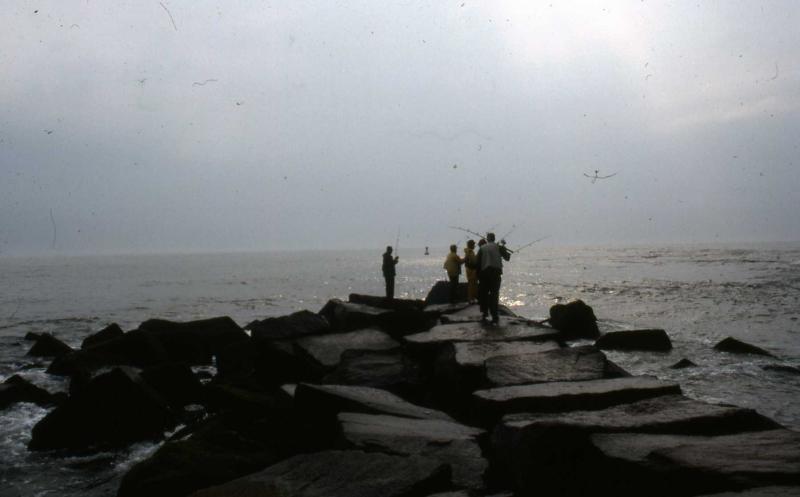Indian River Inlet fishing throughout the years
I began fishing Indian River Inlet as a child during the late 1940s and early 1950s. In those days, the inlet was controlled by a sheet of metal that was rusty and got very hot in the summer sun. Folks would line up along the shoreline, bait up with either minnows or squid – sometimes both – and wait for a bite. The primary target was a nice, fat flounder; the catch was very small black sea bass and smooth dogfish that we called sand sharks.
As I remember, this was a family affair. There were cars parked in the empty lot on the north side of the inlet, and folding chairs were broken out along with a nice picnic lunch. I was the only one in my family who wanted to fish, but my stepfather made sure I was set up properly. The only fish I remember catching were the aforementioned sea bass and sand sharks. Then as now, I donated numerous rigs to the bottom structure.
When I returned from my four years in the Navy in 1965, both the inlet and I had changed. The steel sheeting at the inlet was gone, replaced by large rocks, and I had the latest in fishing equipment, a Mitchell 302 spinning reel that I bought at the PX while my ship, the USS Saratoga, was in France. I matched that reel to a rod I bought at the Boothwyn Farmers Market. I still have both.
I met the love of my life, Barbara Twilley, in February 1965, and she had four sisters. One, Joy, was already married to Bobby Woods, and another, Cheryl, was dating the late Paul Coffin. If it is possible, both men were almost as crazy about fishing as I was.
All three couples began camping every weekend at the south side of Indian River Inlet and fishing the inlet as the tides allowed. If we had incoming between 11 p.m. and 4 a.m., that’s when we fished.
Striped bass, or rockfish as we called them, were the main target. We used a white bucktail with a white or purple worm that we worked as close to the rocks as possible. We learned how to feel the difference between the strike of a fish and the snag of a boulder. Still, even the best of us lost some gear every night.
During the day, we kept our eyes out for blues. They could come in on the tide chasing bait on the surface. Tossing a metal lure like a Hopkins was the best way to catch them. Feed them bucktails or a soft plastic bait, and you only got one fish per lure.
We also fished with bait. Drifting sand fleas was a good way to catch rockfish day or night. Fish with bloodworms and you caught winter flounder in the spring. Bloodworms would also attract stripers.
In 1965, I went to work for RCA as an electronics tech. Since I was the last hire, I had the last choice for my vacation. The only week left was in early May, so I grabbed my tent and headed for Indian River Inlet.
The first evening, I fished for shad from the south side where the beach and the inlet meet. The shad were thick and ate my shad darts like candy. I thought I saw some bigger fish in the mix, so I snapped on a black back Rebel WindCheater and made a cast. That big bluefish gobbled up the plug and the fight was on. When it was over, I had landed the first blue of the season.
I have also spent many hours fishing the inlet from boats. My first was a 14-foot tin boat with no bells or whistles. I was able to score a good price on a 35-horsepower Evinrude motor through the Evinrude discount plan for outdoor writers. That 35 pushed my boat as fast as I wanted to go. I bought a long tiller and ran the boat standing up.
We fished for summer flounder at the duck blind where I caught my personal best, an 8-pounder, on a minnow drifted without weight.
While the duck blind wasn’t exactly the inlet, it was close. We did catch flounder out of the inlet by drifting live minnows along the Coast Guard wall, Bubblegum Beach, the south side from the end of the campground to the trailer park, now the site of some very nice townhomes. I avoided drifting the north side rocks because too many people fished from there.
We caught big trout from the inlet, the beach, and of course, Delaware Bay. The hot lure at Indian River Inlet was a yellow bucktail with a purple worm.
Now, most of the inlet is being repaired, and we have no idea what that will do to the fishing. The only way to find out is to get out there once the contractors are finished. That’s what I hope to do. See you there!



















































